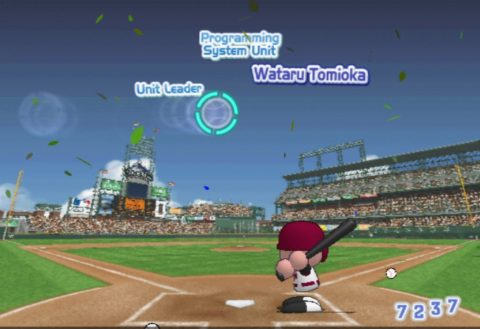Tucked away in a montage of releases during the February 2023 Nintendo Direct was the announcement of WBSC eBaseball: Power Pros. Little would give any indication it’s a long-running Konami franchise without familiarity of the brand. Despite the game itself being a modest offering at 99 cents and features mainly geared towards online gaming, it was a reason to celebrate for some beyond Konami selling basic merchandise at their American store. To understand why requires going back to 2007 when the uniquely Japanese franchise came to America for a short while.
Power Pros is a baseball series started in 1994 and has become iconic in Japan for its use of super deformed characters with disconnected feet. Even with new technology, the look of Japanese professional baseball players rendered into mushroom-esque chibis endured and became its signature. Despite selling millions in Japan, that aspect would also keep its prospects in the West dim with the audience demanding more realistic renditions.
Even without Western support, Konami started producing alternate version Jikkyo Powerful Major League in 2006 with an American focus after phenoms like Ichiro Suzuki and Daisuke Matsuzaka broke into Major League Baseball. On top of that, the pack-in to Nintendo’s new console, Wii Sports, became a frenzy the same year, opening the market to a wider array of titles. With the stars aligning, Konami teamed with publisher 2K Sports, then gatekeeper of the pro baseball licenses, to release the second game in the series as MLB Power Pros in America for PlayStation 2 and Wii in October 2007.
Addressing the obvious first, the visuals leave a better impression in action. Despite lacking mouths, the faces are surprisingly expressive and the superdeformed heads allow instant input to on-field action. Pitchers and batters will side-eye the umpire, fielders will kick the ground when they botch an easy play, and even missing legs don’t stop superstars’ wind-ups and batting rituals from being lovingly recreated.
Most stadium depictions will stand their ground against the game’s contemporaries even with softened features. When the ball is in play, however, the graphics are simplified with 2D crowds and cartoony surroundings. It does allow the action to be quick with few performance issues. The only major drawback is texture blur is frequent, while the difference between digitized and rendered features is outright glaring.
If there is a part of the aesthetic that can be detrimental, it’s the audio. The music’s light rock cues are good, but the in-game sounds are empty, with the atmosphere capturing a cavernous stadium with 200 people in it. The commentary by Kent Merluzzi is fine, if too breathlessly excited. However, many phrases like “he’s seeing the ball pretty well today” can loop during a game, and sometimes during a single at-bat.
The bread and butter of a Power Pros title is the gameplay. One of the forerunners of realistic batting physics by emphasizing how the ball is hit, players have a hitting area around the bat that can be moved and switched to a power swing with a significantly smaller circle. Basic contact will allow for safer bets when re-adjusting to the pitch, but chances of smashing an extra-base hit are more limited. Despite being simple to use and understand, even getting the ball into the power circle doesn’t guarantee a home run. Hitting the ball in the wrong spot can pop it straight up or drill it into the ground.
Pitching is even easier. Every pitcher has a set of throws that can be selected with the left analogue stick. After selecting a pitch, it’s merely pointing to the desired direction of the plate and throwing it. Having an array of curveballs and sliders mixed with heaters is essential since, depending on settings, a pitcher can use movement to completely fool the batter. There are control and stamina stats that affect play, and even perks (or anti-perks in the case of “Choke Artist” that debilitates the player in pressure situations) which determine how steady the pitcher is moment-to-moment. Difficulty options can go both ways and either make a bat hone in on the pitch location, or remove the pitch marker entirely, turning every ball and strike into a guessing game.
Players can create their dream team, build a league with friends, and even unlock a Smash Bros.-esque shooting gallery with the game’s currency. With an extra $10 cost for their port at release, Wii owners could utilize a section that grafts motion controls onto standard Exhibition and Home Run Derby. The controls replace button inputs instead of making a motion-based engine, so it’s more stiff than Wii Baseball. However, it’s still a decent option due to utilizing real teams, players, and stadiums as well as Miis. The Wii version is also preferred due to the PS2’s slightly longer loading times and severely limited memory card storage.
The core of MLB Power Pros lies in its “Season” and “Success” modes. Season is a bit of a misnomer since it’s essentially running a baseball team for a decade. It has a marginal story with the player cast as a recent college graduate who has been given the General Manager position thanks to a penny-pinching owner. One can either take the mantle of the Yankees and sim through entire seasons, or build an entirely new expansion team made of rookies and free agency cast-offs the player turns into champions. Customization is good for a 2007 game and will likely provide enough material to create something that works, but if building a franchise from scrubs isn’t desirable, the entire league can be redrafted. Be warned: An all-star team requires an all-star salary, or points in the case of this game’s setup. If the General Manager runs out of points garnered from team performance, it’s immediate game over.
Running the front office is a blast and not as taxing as more realistic baseball sims. Occasional A.I. quirks do throw a wrench into plans. After the first day of a new season, computer-controlled teams will sign every position player in free agency, and automated decision-making will occasionally make bullpen pitchers start games without player supervision. Unfortunately, the G.M.’s sweet, patient assistant who will gladly explain everything spreads the tutorial over weeks, sometimes well after there’s already a mess.
Almost a decade before Spike Lee exploded the NBA 2K series’ player creation into a yearly Hollywood production, Power Pros’ quirky Success mode was one of the most unique features in sports gaming. A stat-building visual novel with dating aspects and a card system, it’s not the same kind of marvel, but it does underline the charm and humor of the franchise while setting up the surprising amount of technical aspects under the hood.
The player will guide mascot Power Pro-chan through an extremely eccentric college baseball team, working his way up with his best friend Marvin, maybe finding love, or hanging out with the ghost of a professional player who occasionally possesses people. Naturally. The off-the-wall story is supplemented with situations like fighting a grocery store customer for the last power-up in stock that requires randomly-distributed Fate Cards with basic responses to resolve them.
The goal of all of this is to defeat a villainous team, impress a scout enough to get a MLB contract, and maybe even receive a matchup against a dream lineup of Major Leaguers unusually adamant about challenging a college squad. Then at last, the game will unlock its character customization and allow them to be used in other modes. Everything is connected to either building the character’s stats or crossing progression goalposts, like class grades or scout approval. Even dating can give an extra edge with presents or connections to powerful family members.
Despite the goofy story with bizarre characters, it has surprising difficulty. The highest stat increases come from tournament games, of which only the created player can be controlled. The rest is simulated, which is unkind to rag-tag underdogs. Whether playing pitcher or batter, the rest of the team can be hopelessly awful and easily get knocked out without enough scout approval to clear the story. Getting through will require tons of saving, and recording data is a “Save and Exit” hassle with only one save slot allowed on Success mode.
This doesn’t even get into “Motivation” and the Fate Card system. Motivation affects every aspect of the character, from their batting range to the Fate Cards they can select. The random nature of the cards is already troublesome, as four “NO” cards can be left to decide whether to take a basic test for easy points, but getting Motivation hits can lower card selection to one. Even trying to save certain cards can bring about a social debuff that reduces it anyway. All of this can spike an ideal run and blemishes an otherwise delightful feature.
MLB Power Pros 2008 – Wii, 3DS (2007)
Thankfully, next year’s MLB Power Pros 2008 does away with the card system entirely in its Success mode about Power Pro-chan and Marvin waltzing humorously stone-faced through a minor league baseball system drunk on its own melodrama. There is also a sandbox open world, leaving more decisions in the hands of the player.
The follow-up game ditched the PlayStation 2 port for a 3DS version sadly stripped to the bone of features, but the Wii edition has various improvements and one new mode. While running the front office in Season is almost exact except for character art changes, there are tweaks between rookies and allstars that make the differences between a cheap franchise and perennial powerhouse greater. Along with the less frustrating Success experience, the created player’s existence can be expanded in MLB Life, where the avatar (or ANY MLB player, for that matter) can be used to live out an entire career.
MLB Life is underdeveloped as even the main franchise just had it implemented, but there is a clunky wackiness to its experience. The player must keep track of contacts from agents to a portfolio of single women simply labeled “LADY” with the only reliable way of keeping everyone happy is an endless parade of lunches. Marriage gives the ability to have a child that adds a single aesthetic addition to the game. For player development, getting new pitches requires reading comics to become “a person of culture,” able to parse the text of difficult pitching tomes. While there are other hobbies that can increase stats, they pale in comparison to using the time to work out instead with a fatigue penalty that can be easily remedied by a variety of products, including a hyperbaric sleep chamber.
Everything here is shallow and literally wears its flaws on its sleeves, as post-game debriefs leave the character with glitched patches of flesh coloring on their uniform. Yet it is that jank that gives it loose customization reins. If practical differences between actions are so miniscule and the social rewards aside from contract negotiations are nothing, why not read romance novels, be best friends with the backup shortstop, or marry the cute clerk from the sporting goods store instead of the rude actress?
Even though a Jikkyo Powerful Major League game was released in Japan for the 2009 season, an American localization never materialized. Despite accounts that sales were poor (Most articles and Youtubers use VGChartz numbers, which are unverified and do not list sources), both the creators in Japan and statements from the publisher have said otherwise. One of the only public explanations given was an e-mail by a 2K representative which stated the company had three in-studio pro baseball games on the docket for 2009, leaving no room for Power Pros. There would only be MLB Power Pros 2010 for cell phones before Konami took a hard swerve to its American baseball branding.
Konami released MLB Bobblehead Pros themselves digitally for the Xbx 360 in 2011 as an attempt to make the franchise a better fit in America. The chibi characters were replaced by literal bobbleheads with spring necks. Despite having the same gameplay, visuals properly upgraded to new consoles, and online capability, the unfortunate artistic decision severely hinders the appeal. Digging trenches in the uncanny valley, the motionless faces and lifeless, unblinking eyes combine with the more realistic stadium renderings and removal of broadcast commentary to create something more akin to a scene from The Twilight Zone than an entertaining baseball experience. The new attempt at a franchise also had the Xbobasx Live Arcade release MLB Bobblehead Pros Battle focused on batting and creating obstacle-filled stadiums later that year. Without 2K Sports’ American marketing team, neither got much traction and were quietly delisted in 2013.
Despite only having a two-year console run in the States, the games have developed a following similar to the Super Nintendo’s Ken Griffey Jr. Presents Major League Baseball. While closer in gameplay to the original R.B.I. Baseball (Itself a localization of a Japanese title), Power Pros shares Griffey’s mix of fast and addictive pacing with cartoony graphics that were passed over by some audiences and critics initially, but have since become far more endearing than many of their contemporaries. Along with gameplay, the ambition of the franchise matches the pinnacles of sports games such as NFL 2K5, and the only thing they lack from being true landmarks is the full refinement of features the future Japanese Power Pros got. On the other hand, NFL 2K5’s features celebrity A.I. opponent Steve-O from Jackass making weaksauce taunts at gamers every 20 seconds, so perhaps the refinement of certain things isn’t as much of a factor as it seems.
Links
MLB Bobblehead Pros Trailer:
https://www.youtube.com/watch?v=8lqishlmjZI
MLB Bobblehead Pros Delisting:
2K Sports Statement on canceling MLB Power Pros:
https://www.mlbppworld.com/viewtopic.php?f=1&t=2663&st=0&sk=t&sd=a
If you want to hear Steve-O from Jackass mug through lines during a game of NFL 2K5 for an hour and a half:
https://www.youtube.com/watch?v=1MkL6ogqmNU
VG Chartz, whether you believe them or not:
https://www.vgchartz.com/game/7569/mlb-power-pros/?region=All
https://www.vgchartz.com/game/7647/mlb-power-pros/?region=All
https://www.vgchartz.com/game/23587/mlb-power-pros-2008/?region=All
Super long interview with the makers of Power Pros (In Japanese): https://news.denfaminicogamer.jp/projectbook/pawapuro_mingol
Most notable, this quote from Hiroshi Tanibuchi, director/producer of many versions of Power Pros:
“Well, it’s quite difficult to have people play overseas. We tried our best, and in the past it sold well, but it was still tough. After all, it is classified as a “game for children” because of its cute appearance. People ask me, “Why are you playing real baseball with this character?”


